2006 Hyundai Terracan check oil
[x] Cancel search: check oilPage 479 of 539
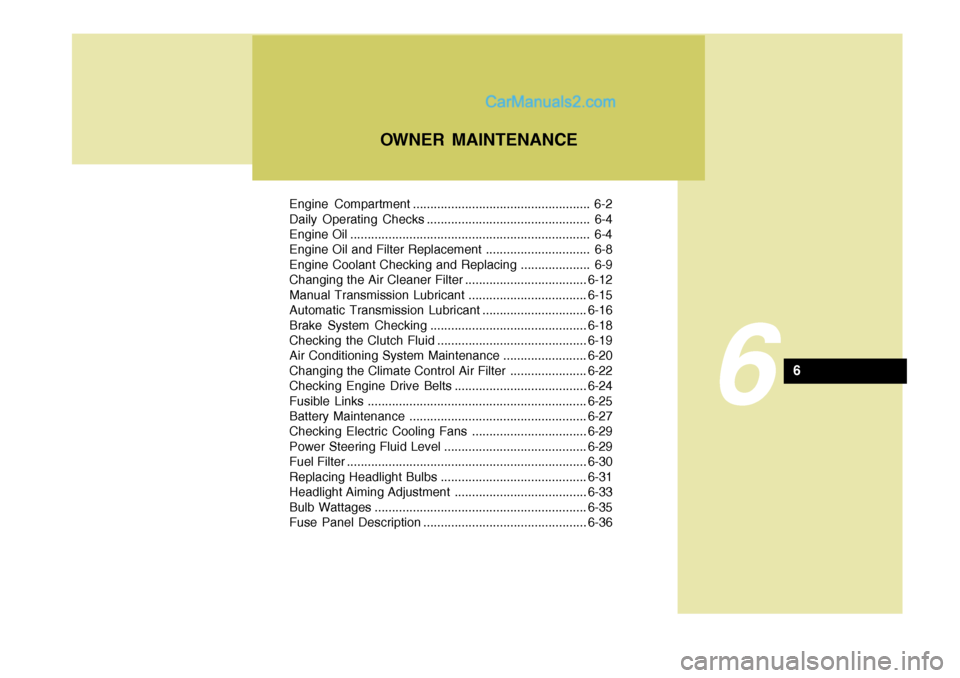
Engine Compartment ................................................... 6-2
Daily Operating Checks ............................................... 6-4
Engine Oil ..................................................................... 6-4
Engine Oil and Filter Replacement .............................. 6-8
Engine Coolant Checking and Replacing .................... 6-9
Changing the Air Cleaner Filter ...................................6-12
Manual Transmission Lubricant ..................................6-15
Automatic Transmission Lubricant ..............................6-16
Brake System Checking ............................................. 6-18
Checking the Clutch Fluid ........................................... 6-19
Air Conditioning System Maintenance ........................ 6-20
Changing the Climate Control Air Filter .. ....................6-22
Checking Engine Drive Belts ...................................... 6-24
Fusible Links ............................................................... 6-25
Battery Mai ntenance ................................................... 6-27
Checking Electric Cooling Fans .................................6-29
Power Steering Fluid Level ......................................... 6-29
Fuel Filter ..................................................................... 6-30
Replacing Headlight Bulbs .......................................... 6-31
Headlight Aiming Adjustment ...................................... 6-33
Bulb Wattages ............................................................. 6-35
Fuse Panel D escription ............................................... 6-36
OWNER MAINTENANCE
6
6
Page 482 of 539
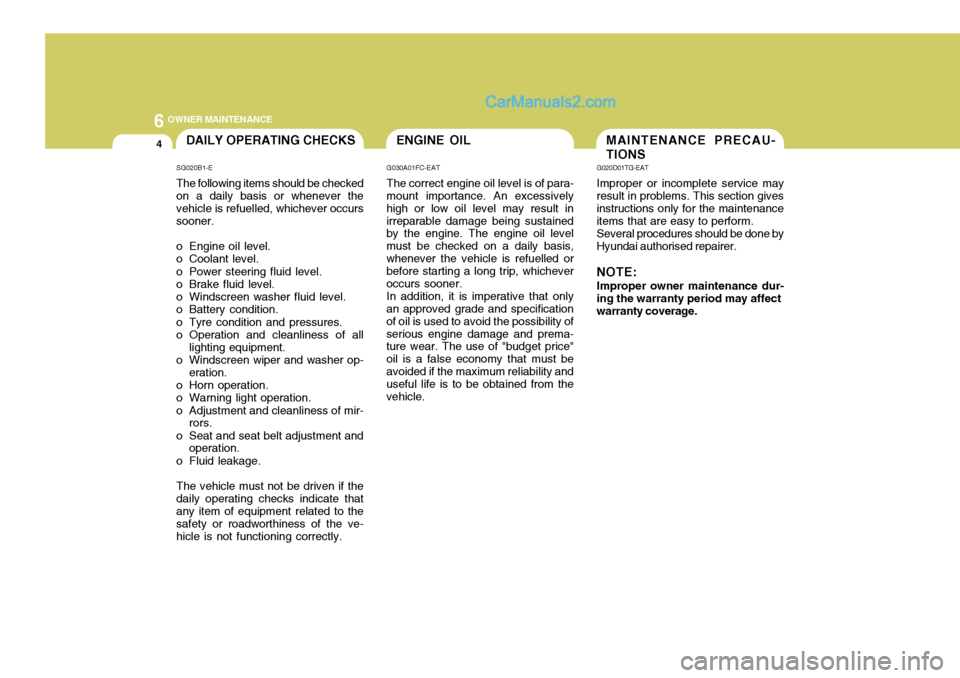
6 OWNER MAINTENANCE
4DAILY OPERATING CHECKS
SG020B1-E The following items should be checked on a daily basis or whenever the vehicle is refuelled, whichever occurssooner.
o Engine oil level.
o Coolant level.
o Power steering fluid level.
o Brake fluid level.
o Windscreen washer fluid level.
o Battery condition.
o Tyre condition and pressures.
o Operation and cleanliness of all lighting equipment.
o Windscreen wiper and washer op-
eration.
o Horn operation.
o Warning light operation.
o Adjustment and cleanliness of mir- rors.
o Seat and seat belt adjustment and operation.
o Fluid leakage. The vehicle must not be driven if the daily operating checks indicate that any item of equipment related to the safety or roadworthiness of the ve-hicle is not functioning correctly.ENGINE OIL
G030A01FC-EAT The correct engine oil level is of para-
mount importance. An excessively high or low oil level may result inirreparable damage being sustained by the engine. The engine oil level must be checked on a daily basis,whenever the vehicle is refuelled or before starting a long trip, whichever occurs sooner.
In addition, it is imperative that only
an approved grade and specificationof oil is used to avoid the possibility ofserious engine damage and prema- ture wear. The use of "budget price" oil is a false economy that must beavoided if the maximum reliability and useful life is to be obtained from the vehicle.MAINTENANCE PRECAU- TIONS
G020D01TG-EAT Improper or incomplete service may
result in problems. This section gives instructions only for the maintenanceitems that are easy to perform.
Several procedures should be done by
Hyundai authorised repairer.
NOTE: Improper owner maintenance dur-
ing the warranty period may affect warranty coverage.
Page 484 of 539
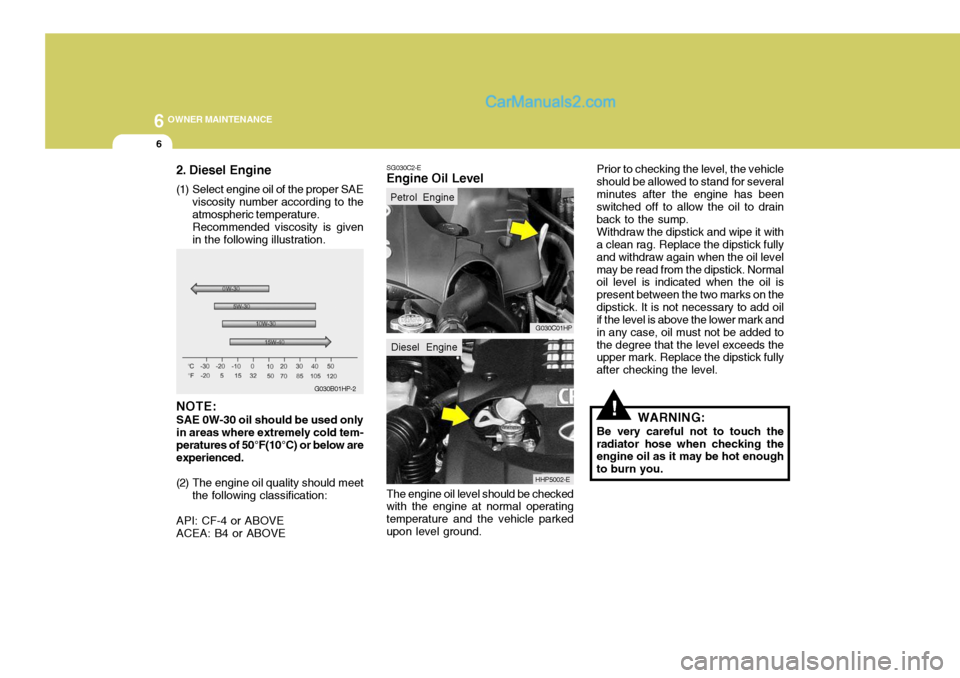
6 OWNER MAINTENANCE
6
SG030C2-E
Engine Oil Level
The engine oil level should be checked with the engine at normal operating temperature and the vehicle parkedupon level ground. Prior to checking the level, the vehicle
should be allowed to stand for severalminutes after the engine has been switched off to allow the oil to drain back to the sump.
Withdraw the dipstick and wipe it with
a clean rag. Replace the dipstick fullyand withdraw again when the oil levelmay be read from the dipstick. Normal oil level is indicated when the oil is present between the two marks on thedipstick. It is not necessary to add oil if the level is above the lower mark and in any case, oil must not be added tothe degree that the level exceeds the upper mark. Replace the dipstick fully after checking the level.
HHP5002-E
Petrol Engine
Diesel Engine
G030C01HP
!WARNING:
Be very careful not to touch the
radiator hose when checking the engine oil as it may be hot enough to burn you.
2. Diesel Engine
(1) Select engine oil of the proper SAE
viscosity number according to the atmospheric temperature.Recommended viscosity is givenin the following illustration.
NOTE: SAE 0W-30 oil should be used only in areas where extremely cold tem- peratures of 50°F(10°C) or below are experienced.
(2) The engine oil quality should meet the following classification:
API: CF-4 or ABOVEACEA: B4 or ABOVE
G030B01HP-2
Page 485 of 539
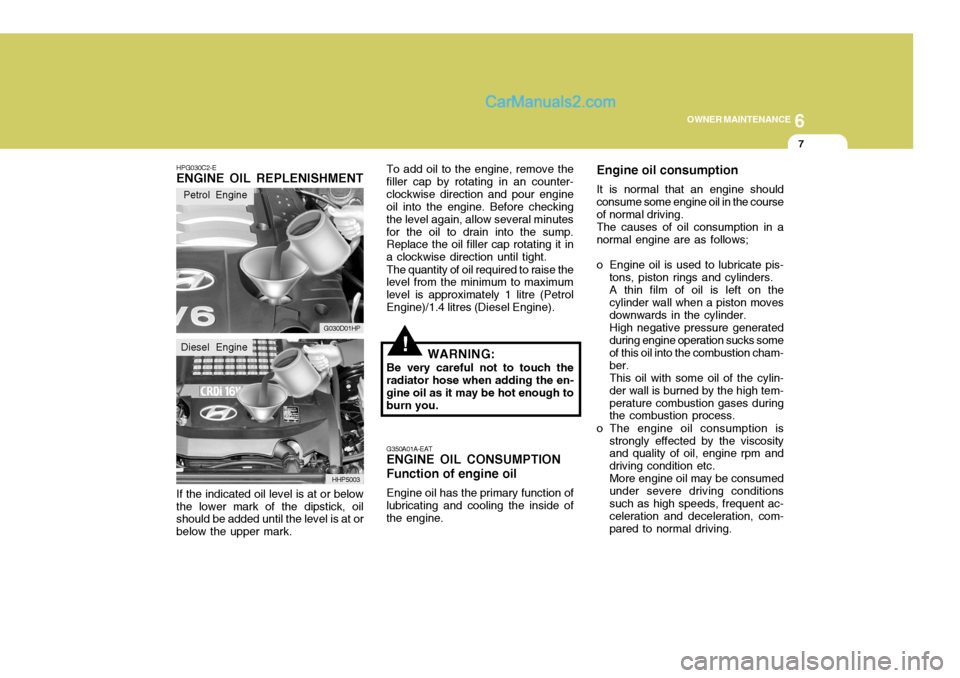
6
OWNER MAINTENANCE
7
G350A01A-EAT
ENGINE OIL CONSUMPTION Function of engine oil
Engine oil has the primary function of
lubricating and cooling the inside of the engine.
HPG030C2-E
ENGINE OIL REPLENISHMENT
If the indicated oil level is at or below the lower mark of the dipstick, oil should be added until the level is at or below the upper mark. Engine oil consumption It is normal that an engine should consume some engine oil in the course of normal driving.The causes of oil consumption in anormal engine are as follows;
o Engine oil is used to lubricate pis-
tons, piston rings and cylinders. A thin film of oil is left on thecylinder wall when a piston movesdownwards in the cylinder.High negative pressure generatedduring engine operation sucks some of this oil into the combustion cham- ber.This oil with some oil of the cylin-der wall is burned by the high tem-perature combustion gases during the combustion process.
o The engine oil consumption is strongly effected by the viscosityand quality of oil, engine rpm and driving condition etc.More engine oil may be consumedunder severe driving conditionssuch as high speeds, frequent ac- celeration and deceleration, com- pared to normal driving.
HHP5003
G030D01HP
Petrol Engine
Diesel Engine!
To add oil to the engine, remove the filler cap by rotating in an counter-clockwise direction and pour engine oil into the engine. Before checking the level again, allow several minutesfor the oil to drain into the sump. Replace the oil filler cap rotating it in a clockwise direction until tight. The quantity of oil required to raise the level from the minimum to maximum level is approximately 1 litre (PetrolEngine)/1.4 litres (Diesel Engine).
WARNING:
Be very careful not to touch the
radiator hose when adding the en-gine oil as it may be hot enough toburn you.
Page 487 of 539
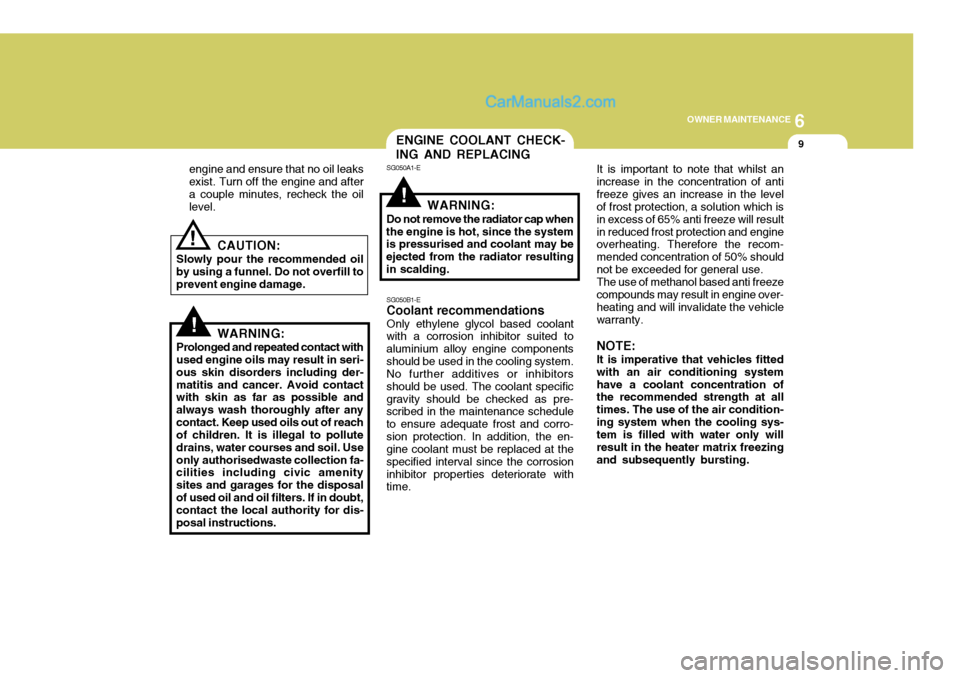
6
OWNER MAINTENANCE
9
!
!
engine and ensure that no oil leaks exist. Turn off the engine and aftera couple minutes, recheck the oil level.
CAUTION:
Slowly pour the recommended oil by using a funnel. Do not overfill to prevent engine damage.
WARNING:
Prolonged and repeated contact withused engine oils may result in seri- ous skin disorders including der-matitis and cancer. Avoid contact with skin as far as possible and always wash thoroughly after anycontact. Keep used oils out of reach of children. It is illegal to pollute drains, water courses and soil. Useonly authorisedwaste collection fa- cilities including civic amenity sites and garages for the disposalof used oil and oil filters. If in doubt, contact the local authority for dis- posal instructions. WARNING:
Do not remove the radiator cap when
the engine is hot, since the system is pressurised and coolant may be ejected from the radiator resultingin scalding.
SG050B1-E
Coolant recommendations
Only ethylene glycol based coolant
with a corrosion inhibitor suited toaluminium alloy engine componentsshould be used in the cooling system. No further additives or inhibitors should be used. The coolant specificgravity should be checked as pre- scribed in the maintenance schedule to ensure adequate frost and corro-sion protection. In addition, the en- gine coolant must be replaced at the specified interval since the corrosioninhibitor properties deteriorate with time.
ENGINE COOLANT CHECK- ING AND REPLACING
SG050A1-E
! It is important to note that whilst an increase in the concentration of antifreeze gives an increase in the level of frost protection, a solution which is in excess of 65% anti freeze will resultin reduced frost protection and engine overheating. Therefore the recom- mended concentration of 50% shouldnot be exceeded for general use.The use of methanol based anti freezecompounds may result in engine over-heating and will invalidate the vehicle warranty. NOTE: It is imperative that vehicles fitted with an air conditioning systemhave a coolant concentration of the recommended strength at all times. The use of the air condition-ing system when the cooling sys- tem is filled with water only will result in the heater matrix freezingand subsequently bursting.
Page 509 of 539

6
OWNER MAINTENANCE
31
!
!
3. Check to be sure that the warning
lamp illuminates when the ignition key is turned to "ON", and that it goes off when the engine is started. If in doubt, consult your nearest Hyundai authorised repairer.
NOTE: It is recommended that water accu- mulated in the fuel filter should be removed by a Hyundai authorised repairer.
WARNING:
Be sure to carefully wipe away anywater drained out in this manner, because the fuel mixed in the water might be ignited and resultin a fire. Before attempting to replace a head-
light bulb, be sure the switch is turned to the "OFF" position.
The next paragraph shows how to
reach the headlight bulbs so they may be changed. Be sure to replacethe burned-out bulb with one of the same number and wattage rating.
Ensure that the replacement bulb has
the same cap configuration and watt-age as the original.
See page 6-35 for the wattage descrip-
tions.
CAUTION:
Keep the lamps out of contact with
petroleum products, such as oil, petrol, etc.
REPLACING HEADLIGHT BULBS
G260A01HP-EAT
G300B02HP-EAT
Removal Of Water From TheFuel Filter (For Diesel Engine)
If the fuel filter warning lamp illumi- nates during driving, it indicates that water has accumulated in the fuel filter. If this occurs, remove the wateras described below.
1. Loosen the drain plug at the bot- tom of the fuel filter.
2. Tighten the drain plug when water no longer comes out.
HHP5047-E
Page 520 of 539

7EMISSION CONTROL SYSTEMS
2
Inspect the exhaust systemWhenever a change is noticed in the
sound of the exhaust system, the underside or rear of the vehicle maybe damaged. You should inspect the exhaust system each time the car is raised for lubrication or oil change. To check condition
1. Holes and gas leaks due to corro- sion, damage, etc., should be recti- fied.
2. The joints should be checked for loose connections and gas leakage.
3. The hanger rubber and brackets
should be checked for damage.EXHAUST GAS WARNING
H030A01HP-EAT Exhaust gases contain carbon monox- ide, a potentially toxic gas that is colorless and odorless. Avoid breath-ing exhaust gases.
o Do not run the engine in confined areas, such as garages, any longer than necessary to move the car inor out.
o Do not drive with the tailgate door
open. An open tailgate door maydraw exhaust gases into the pas- senger compartment. If you must drive with the tailgate door open,drive only with all the windows wide open and the blower motor on high speed.
o If it is necessary to sit in a parked
car with the engine running formore than a short period, adjust your heating system to force out- side air into the car by placing theair selector button of the heater in the FRESH AIR position and mode control in the VENT position. Setthe fan at high speed and the con- trols in any position desired.EMISSION CONTROL SYS- TEMS
ZH010A1-E
(Not all models)
Your Hyundai is equipped with an
emission control systems. There are three emission control sys-
tems which are as follows.
(1) Crankcase emission control sys- tem (For a Petrol Engine)
(2) Evaporative emission control sys- tem (For a Petrol Engine)
(3) Exhaust emission control system
In order to assure the proper function
of the emission control system, it is recommended that you have your car inspected and maintained by a Hyundaiauthorised repairer in accordance with the schedule in this manual.